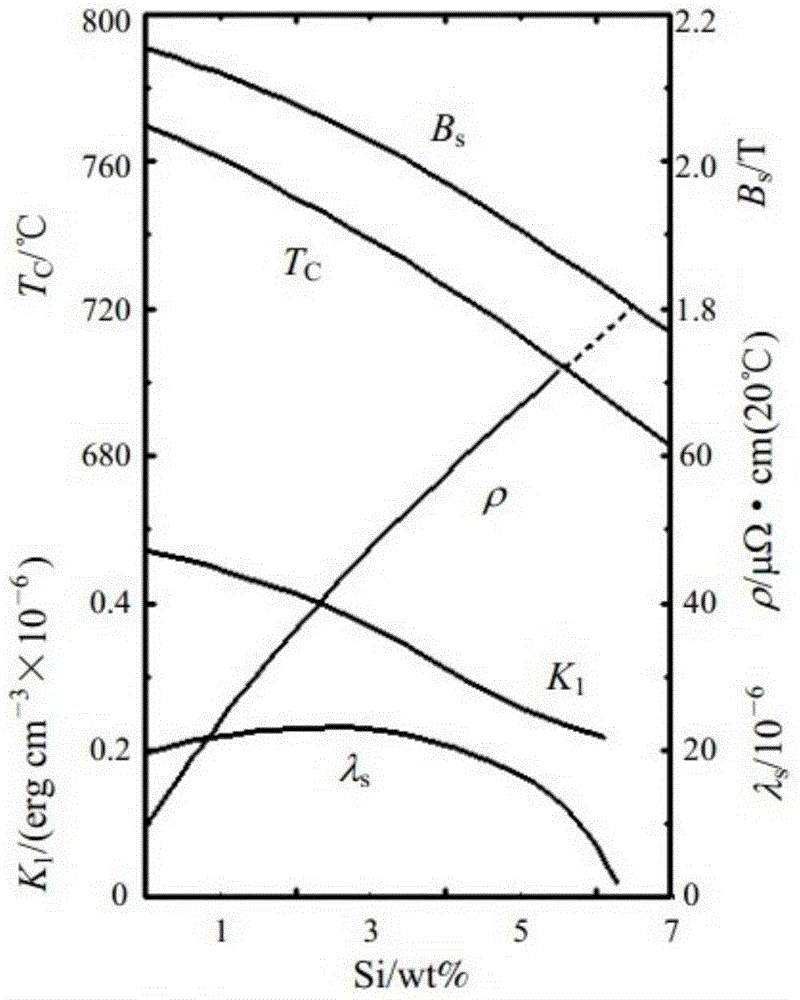FeSi magnetic powder core and manufacturing method thereof
A technology of iron-silicon powder and magnetic powder core is applied in the field of iron-silicon magnetic powder core and its preparation, which can solve the problems of ineffective isolation of powder particles and particles and high loss, and achieves improved DC superposition characteristics, low production cost, and reduced magnetic loss. Effect
- Summary
- Abstract
- Description
- Claims
- Application Information
AI Technical Summary
Problems solved by technology
Method used
Image
Examples
Embodiment 1
[0027] The influence of embodiment 1Si, Ni or Co on the soft magnetic properties of iron-silicon powder
[0028] 1. Mix silicon and iron with different contents, put them in a smelting furnace, and melt them into molten steel at 1500-1800°C, then flow the molten steel into the atomizer at a speed of 10-20 kg per minute, and pass through 40-100MPa The high-speed nitrogen generated by high pressure pulverizes molten steel to make iron-silicon powder.
[0029] from figure 1 It can be seen from the figure that when the silicon content is 5-7%, the magnetostriction coefficient λs and the magnetocrystalline anisotropy constant κ1 of the alloy are lower, and the resistivity ρ is higher, so the loss is lower and the soft magnetic properties are better. excellent.
[0030] 2. Taking the silicon content of 6% as an example, adding different contents of Ni or Co elements to the iron-silicon alloy, it can be seen from the following table 1 that adding a small amount of Ni or Co elements...
Embodiment 2
[0034] In this embodiment, the composition of the iron-silicon powder alloy is: 5% Si, 1.5% Ni, and the rest is Fe. It is prepared by the aerosol method. The specific steps of the aerosol method are: put Si, Ni, and Fe in a melting furnace, melt them into molten steel at 1500-1800°C, and then melt the molten steel at a rate of 10-100°C per minute. The speed of 20 kg flows into the atomizer, and the high-speed nitrogen gas generated by the high pressure of 40-100 MPa pulverizes the molten steel to obtain iron-silicon powder. The particle size distribution of the iron-silicon powder is as follows: 150 mesh ≤ particle size < 200 mesh accounts for 10%; 200 mesh ≤ particle size < 325 mesh accounts for 60%; particle size ≥ 325 mesh accounts for 30%.
[0035] The preparation method of iron-silicon magnetic powder core is:
[0036] 1) Take ferrosilicon powder, add 1% potassium permanganate as a passivation agent, then heat water to dilute and mix well, and fry to dry;
[0037] 2) Ad...
Embodiment 3
[0052] In this embodiment, the composition of the iron-silicon powder alloy is: 7% Si, 0.1% Co, and the rest is Fe. It is prepared by the aerosol method. The specific steps of the aerosol method are: put Si, Co, and Fe in a melting furnace, melt them into molten steel at 1500-1800°C, and then melt the molten steel at a rate of 10-100°C per minute. The speed of 20 kg flows into the atomizer, and the high-speed nitrogen gas generated by the high pressure of 40-100 MPa pulverizes the molten steel to obtain iron-silicon powder. The particle size distribution of the iron-silicon powder is as follows: 150 mesh ≤ particle size < 200 mesh accounts for 20%; 200 mesh ≤ particle size < 325 mesh accounts for 50%; particle size ≥ 325 mesh accounts for 30%.
[0053]The preparation method of iron-silicon magnetic powder core is:
[0054] 1) Take iron-silicon powder, add 0.01% magnesium permanganate as a passivation agent, then heat water to dilute and mix well, and fry to dry;
[0055] 2) ...
PUM
 Login to View More
Login to View More Abstract
Description
Claims
Application Information
 Login to View More
Login to View More - R&D
- Intellectual Property
- Life Sciences
- Materials
- Tech Scout
- Unparalleled Data Quality
- Higher Quality Content
- 60% Fewer Hallucinations
Browse by: Latest US Patents, China's latest patents, Technical Efficacy Thesaurus, Application Domain, Technology Topic, Popular Technical Reports.
© 2025 PatSnap. All rights reserved.Legal|Privacy policy|Modern Slavery Act Transparency Statement|Sitemap|About US| Contact US: help@patsnap.com



